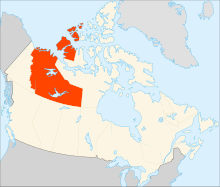Northwest Territories (electoral district)
|
|
|||
|---|---|---|---|
 |
|||
| Federal electoral district | |||
| Legislature | House of Commons | ||
| MP |
Liberal |
||
| District created | 1976 | ||
| First contested | 1979 | ||
| Last contested | 2015 | ||
| District webpage | profile, map | ||
| Demographics | |||
| Population (2011) | 41,462 | ||
| Electors (2015) | 28,795 | ||
| Area (km²) | 1,346,106 | ||
| Pop. density (per km²) | 0.03 | ||
| Census divisions | Region 1, Region 2, Region 3, Region 4, Region 5, Region 6 | ||
| Census subdivisions | Yellowknife, Hay River, Inuvik, Fort Smith, Behchokò, Fort Simpson, Tuktoyaktuk, Fort McPherson, Norman Wells, Fort Providence | ||
|
|
|
|---|---|
| Defunct federal electoral district | |
| Legislature | House of Commons |
| District created | 1962 |
| District abolished | 1976 |
| First contested | 1962 |
| Last contested | 1974 |
Northwest Territories (French: Territoires du Nord-Ouest) is a federal electoral district represented in the House of Commons of Canada.
This riding was created in 1962 from Mackenzie River riding. It was composed of the entire territory of the Northwest Territories. In 1979, the riding was divided into the ridings of Western Arctic and Nunatsiaq (later Nunavut). Following the creation of the territory of Nunavut in 1999, the riding of Western Arctic was made coterminous with the new Northwest Territories.
After 1999, Western Arctic was an anomaly in that, unlike Nunavut and Yukon, it did not share the name of the territory with which it was coterminous. This did not change with subsequent representation orders because the electoral boundaries revision process did not affect the territories and the territorial riding names were specified in law. In 2014, at the behest of Western Arctic MP Dennis Bevington, the riding name was changed to Northwest Territories by Bill C-37, which also changed the names of several other ridings scheduled to come into effect with the representation order for the next election. Unlike those names, the change to Northwest Territories came into effect immediately as it involved amending the Electoral Boundaries Readjustment Act itself.
From 1887 to 1905, the only areas of the NWT with representation in Parliament were those areas that became part of present-day provinces (Alberta, Saskatchewan and western Manitoba). From 1905 to 1947, the NWT was not represented in Parliament. From 1947 to 1962, the southwestern NWT was represented only by the electoral district of Yukon—Mackenzie River and then Mackenzie River. In 1962, the electoral district of NWT was created to represent the entire territory, for the first time giving all Canadian territory a representative in Parliament.
...
Wikipedia
